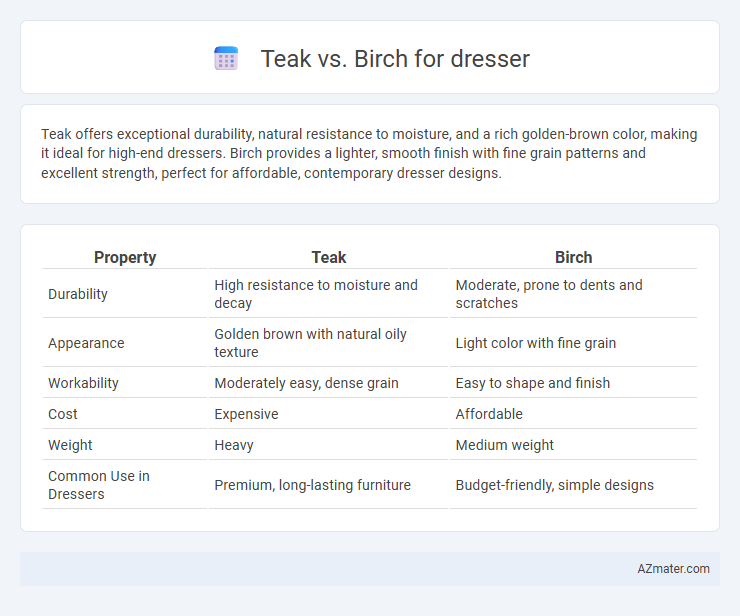Teak offers exceptional durability, natural resistance to moisture, and a rich golden-brown color, making it ideal for high-end dressers. Birch provides a lighter, smooth finish with fine grain patterns and excellent strength, perfect for affordable, contemporary dresser designs.
Table of Comparison
| Property | Teak | Birch |
|---|---|---|
| Durability | High resistance to moisture and decay | Moderate, prone to dents and scratches |
| Appearance | Golden brown with natural oily texture | Light color with fine grain |
| Workability | Moderately easy, dense grain | Easy to shape and finish |
| Cost | Expensive | Affordable |
| Weight | Heavy | Medium weight |
| Common Use in Dressers | Premium, long-lasting furniture | Budget-friendly, simple designs |
Introduction: Understanding Teak and Birch Wood
Teak wood, known for its high oil content and dense grain, offers exceptional durability and water resistance, making it a premium choice for dressers intended to last for decades. Birch wood features a fine grain and light color, providing a smooth surface ideal for detailed finishes and a contemporary aesthetic. Choosing between teak and birch depends on the desired balance of strength, moisture resistance, and visual appeal in dresser construction.
Appearance and Grain Differences
Teak features a rich, warm golden-brown color with a straight grain pattern that often displays natural oily texture, offering a smooth, luxurious finish ideal for dressers. Birch presents a lighter, pale cream to yellow hue with a fine, even grain, producing a clean and uniform appearance that complements modern or minimalist designs. The contrast in grain complexity and color between teak and birch allows for distinct aesthetic choices in dresser construction, with teak providing a more traditional, exotic look and birch offering understated elegance.
Durability and Lifespan Comparison
Teak is renowned for its exceptional durability and natural resistance to moisture, insects, and decay, making it ideal for long-lasting dressers in various environments. Birch, while strong and hard, is more susceptible to wear and damage from moisture and pests, resulting in a comparatively shorter lifespan. Teak dressers typically maintain structural integrity and aesthetic appeal for several decades, whereas birch dressers may require more frequent maintenance and replacement over time.
Resistance to Moisture and Pests
Teak wood is highly resistant to moisture and pests due to its natural oils and dense grain, making it ideal for dressers in humid environments. Birch, though durable, lacks the same level of natural moisture and pest resistance and may require protective finishes to prevent damage. Choosing teak ensures longevity and less maintenance for dressers exposed to varying humidity and insect risks.
Weight and Workability
Teak wood is heavier and denser compared to birch, providing superior durability but making it more challenging to handle and shape during dresser construction. Birch is lighter and exhibits excellent workability characteristics, allowing for easier cutting, sanding, and finishing, which suits detailed craftsmanship and faster production. Choosing between teak and birch depends on the balance desired between weight, durability, and ease of fabrication for dresser projects.
Cost Analysis: Teak vs Birch
Teak wood dressers typically command higher prices due to their durability, natural resistance to pests, and rich golden-brown hue, making them a long-term investment. Birch dressers are generally more budget-friendly, offering a lighter color and smoother grain at a lower initial cost but may require more frequent maintenance or refinishing over time. Evaluating lifecycle costs, teak's superior longevity often offsets its upfront expense compared to birch's affordability but shorter lifespan.
Maintenance Requirements
Teak requires minimal maintenance due to its natural oils that resist moisture, insects, and decay, making it ideal for long-lasting dressers with occasional oiling to preserve its rich color. Birch, while durable, needs more frequent sealing or varnishing to protect against scratches, dents, and moisture damage, increasing upkeep efforts. Choosing teak reduces the frequency of refinishing and repairs, whereas birch demands consistent maintenance to maintain its appearance and structural integrity.
Sustainability and Environmental Impact
Teak offers long-term durability but is often sourced from tropical rainforests, raising concerns about deforestation and habitat loss unless certified by organizations like FSC. Birch, typically harvested from temperate forests with faster growth rates, presents a more sustainable option due to its renewability and lower environmental footprint. Choosing birch reduces carbon impact and supports responsible forestry practices, making it favorable for eco-conscious dresser construction.
Best Applications for Each Wood Type
Teak excels in dresser construction for its durability and natural resistance to moisture, making it ideal for dressers in humid environments or high-traffic areas. Birch is preferred for indoor dressers due to its smooth grain and easy staining properties, offering a versatile surface for various finishes and styles. Teak's rich, oily texture suits classic or rustic designs, while birch fits modern or painted dressers where a more uniform appearance is desired.
Conclusion: Which is Better for Dressers?
Teak offers superior durability, natural resistance to moisture, and a rich, warm tone ideal for long-lasting dressers, while birch provides a lighter color, smoother grain, and more affordable price point suitable for budget-conscious buyers. For dressers exposed to humidity or heavy use, teak's strength and stability make it the better choice, whereas birch excels in environments favoring cost efficiency and ease of finishing. Overall, teak is the preferred wood for premium, enduring dressers, while birch suits decorative or temporary furniture needs.

Infographic: Teak vs Birch for Dresser
 azmater.com
azmater.com